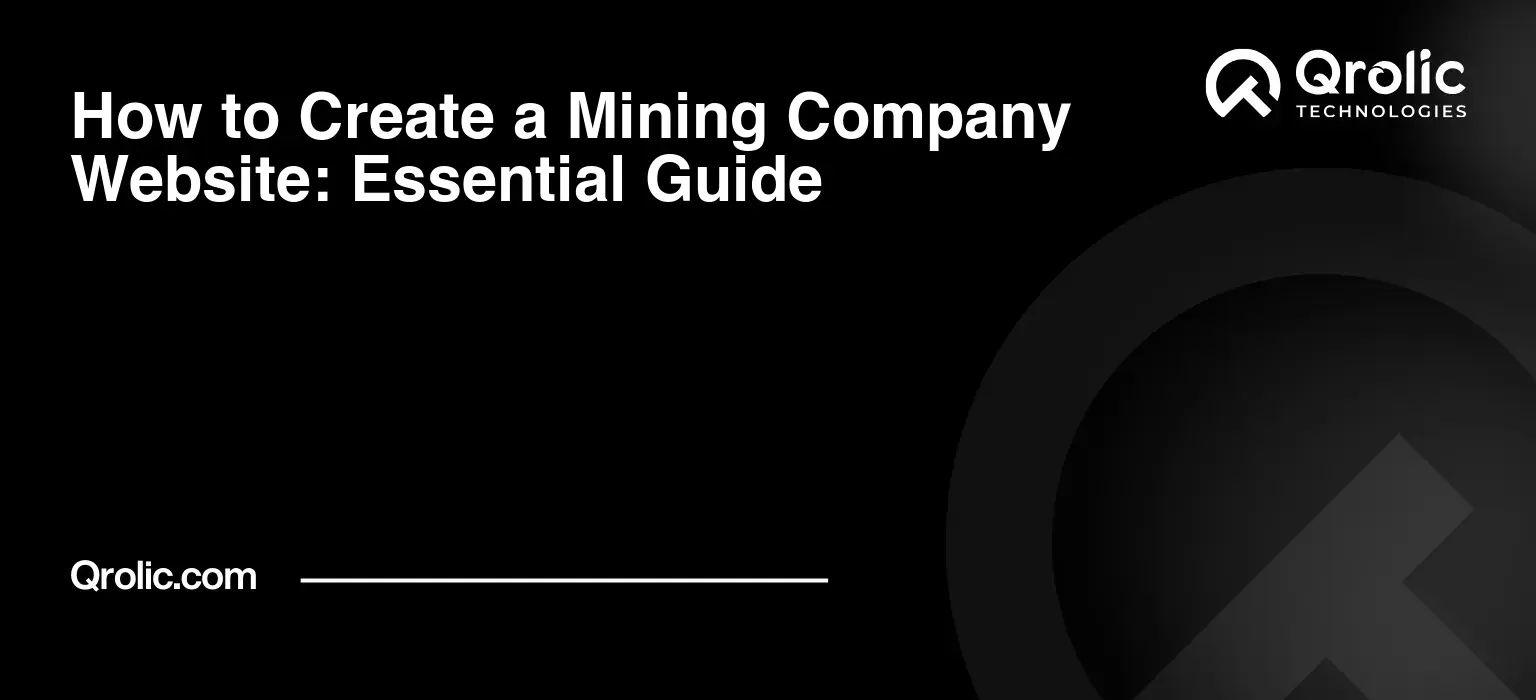Quick Summary:
- A strong website builds trust and attracts investors.
- Showcase projects, safety, and sustainability.
- Plan, design, optimize, and promote your site.
- Consider pros for complex, custom website needs.
Table of Contents
- Understanding the Why: Why Your Mining Company Needs a Website
- Building Credibility and Trust: Showing You’re the Real Deal
- Expanding Your Reach: Unearthing New Opportunities
- Streamlining Communication: Keeping Everyone in the Loop
- Enhancing Operational Efficiency: Working Smarter, Not Harder
- The What: Essential Elements of a Mining Company Website
- Core Pages: The Foundation of Your Online Presence
- Key Content Areas: Digging Deeper into Specific Information
- Essential Features: Enhancing User Experience and Functionality
- The How: Step-by-Step Guide to Creating Your Mining Company Website
- Step 1: Planning and Strategy: Laying the Groundwork for Success
- Step 2: Choosing a Domain Name and Web Hosting: Establishing Your Online Identity
- Step 3: Designing Your Website: Creating a Visually Appealing and User-Friendly Experience
- Step 4: Developing Your Content: Providing Valuable and Engaging Information
- Step 5: Testing and Launching Your Website: Ensuring a Smooth and Successful Launch
- Step 6: Promoting Your Website: Driving Traffic and Generating Leads
- Step 7: Maintaining and Updating Your Website: Keeping Your Online Presence Fresh and Relevant
- The When: When to Invest in Professional Web Design
- The Who: Finding the Right Web Design Partner
- Industrial Web Design: The Specific Needs of Mining Companies
- SEO for Mining Company Websites: Attracting the Right Audience
- Qrolic Technologies: Your Partner in Mining Website Creation
- The Future: Emerging Trends in Mining Company Websites
Understanding the Why: Why Your Mining Company Needs a Website

In today’s digital age, a robust online presence is no longer optional; it’s a necessity. For mining companies, a website isn’t just a digital brochure. It’s a powerful tool that drives growth, builds trust, and streamlines operations. So, why does your mining company need a website? Let’s dig deep.
Building Credibility and Trust: Showing You’re the Real Deal
In an industry often scrutinized for its environmental and social impact, trust is paramount. A professional, informative website demonstrates transparency and commitment.
- Showcasing Projects & Expertise: Highlight successful mining projects, innovative techniques, and the experience of your team. This builds confidence in your capabilities.
- Certifications and Compliance: Clearly display all relevant certifications, permits, and compliance documentation. This assures stakeholders that you operate ethically and responsibly.
- Client Testimonials & Case Studies: Share positive client experiences and detailed case studies showcasing the value you provide. Nothing builds trust like verifiable success stories.
Expanding Your Reach: Unearthing New Opportunities
Your website is your 24/7 global representative. It allows you to reach potential investors, partners, and employees worldwide.
- Attracting Investors: Provide detailed information about your company’s financial performance, projects, and future plans. A compelling online presence can attract vital investment.
- Connecting with Suppliers and Partners: Make it easy for suppliers and partners to find you and understand your needs. Streamline communication and build valuable relationships.
- Recruiting Top Talent: Showcase your company culture, values, and career opportunities. Attract skilled professionals who are passionate about the mining industry.
Streamlining Communication: Keeping Everyone in the Loop
A well-designed website acts as a central hub for all important information.
- Sharing News and Updates: Keep stakeholders informed about project milestones, regulatory changes, and company news.
- Providing Safety Information: Share safety protocols, training materials, and emergency contact information. Prioritize the well-being of your workforce and the community.
- Answering FAQs: Address common questions about your operations, environmental policies, and community engagement initiatives.
Enhancing Operational Efficiency: Working Smarter, Not Harder
A website can streamline many internal and external processes, saving time and resources.
- Online Document Management: Provide access to important documents such as safety manuals, technical specifications, and environmental reports.
- Online Training Modules: Develop online training modules for employees and contractors, reducing the need for in-person sessions.
- Contact Forms and Online Inquiries: Streamline communication by allowing stakeholders to submit inquiries and requests through online forms.
The What: Essential Elements of a Mining Company Website
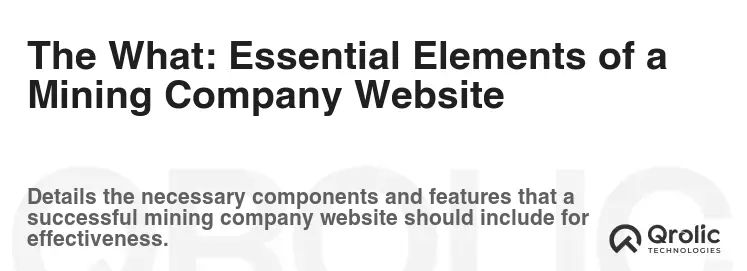
Now that you understand the “why,” let’s focus on the “what.” A successful mining company website requires specific elements that cater to the industry’s unique needs. Here’s a comprehensive checklist:
Core Pages: The Foundation of Your Online Presence
These pages are fundamental to any website, especially one representing a mining company.
- Homepage: Your digital front door. Clearly state your company’s mission, values, and key offerings. Use compelling visuals and a strong call to action.
- About Us: Tell your company’s story. Highlight your history, values, team, and commitment to sustainability and ethical practices.
- Projects: Showcase your mining projects with detailed information, high-quality images, and progress updates.
- Services: Clearly outline the services you offer, whether it’s exploration, extraction, processing, or consulting.
- Sustainability: Dedicated to your environmental and social responsibility initiatives. Detail your commitment to minimizing environmental impact, supporting local communities, and ensuring worker safety. This is crucial for building trust.
- Careers: Attract top talent by showcasing career opportunities, company culture, and benefits.
- Contact Us: Provide multiple ways for people to get in touch, including phone number, email address, and a contact form.
Key Content Areas: Digging Deeper into Specific Information
These sections allow you to provide more in-depth information about your operations and expertise.
- Geology and Exploration: Detail your exploration process, geological data, and mineral resources. This is crucial for attracting investors and technical partners.
- Mining Operations: Explain your mining methods, equipment, and safety procedures. Use visuals to illustrate your processes.
- Processing and Refining: Describe your processing techniques and the final products you produce.
- Environmental Management: Provide comprehensive information on your environmental management plan, including waste management, water conservation, and land reclamation.
- Community Engagement: Showcase your engagement with local communities, including social programs, employment opportunities, and infrastructure development.
- Health and Safety: Prioritize worker safety by detailing your health and safety policies, training programs, and emergency procedures.
- Investor Relations: Dedicated section for investors with financial reports, presentations, and news releases.
- News and Media: Keep stakeholders informed about company news, project updates, and industry events.
- Blog: Share insights, expertise, and industry trends through informative blog posts.
Essential Features: Enhancing User Experience and Functionality
These features will make your website more user-friendly and effective.
- High-Quality Images and Videos: Visuals are crucial for showcasing your operations and projects. Invest in professional photography and videography.
- Interactive Maps: Display the location of your mining sites with interactive maps that provide detailed information about the area.
- Document Downloads: Allow users to download important documents such as reports, permits, and presentations.
- Search Functionality: Make it easy for users to find the information they need by implementing a robust search function.
- Mobile Responsiveness: Ensure your website is accessible and user-friendly on all devices, including smartphones and tablets.
- Multilingual Support: If you operate in multiple regions, offer your website in multiple languages.
- Secure Socket Layer (SSL) Certificate: Protect user data and build trust by installing an SSL certificate.
- Content Management System (CMS): Use a CMS like WordPress, Drupal, or Joomla to easily manage and update your website content.
The How: Step-by-Step Guide to Creating Your Mining Company Website
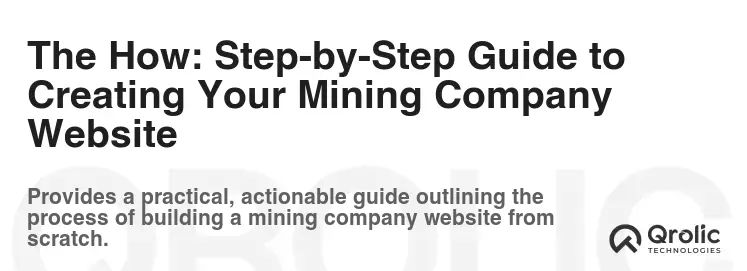
Now that you know what elements you need, let’s break down the process of creating your mining company website into manageable steps.
Step 1: Planning and Strategy: Laying the Groundwork for Success
Before you start building, you need a solid plan. This involves defining your goals, target audience, and key messages.
- Define Your Goals: What do you want to achieve with your website? Increase brand awareness, attract investors, recruit employees, or streamline communication?
- Identify Your Target Audience: Who are you trying to reach? Investors, partners, employees, or local communities?
- Develop Your Key Messages: What are the most important things you want to communicate about your company?
- Conduct Competitor Research: Analyze the websites of your competitors to identify best practices and areas for improvement.
- Create a Site Map: Outline the structure of your website and the relationship between different pages.
Step 2: Choosing a Domain Name and Web Hosting: Establishing Your Online Identity
Your domain name is your online address, and your web hosting is where your website lives.
- Choose a Domain Name: Select a domain name that is easy to remember, relevant to your company, and available. Consider using keywords related to the mining industry.
- Select a Web Hosting Provider: Choose a reliable web hosting provider that offers sufficient storage, bandwidth, and security.
- Consider a Content Delivery Network (CDN): A CDN can improve website speed and performance by caching your content on servers around the world.
Step 3: Designing Your Website: Creating a Visually Appealing and User-Friendly Experience
Your website’s design should be professional, visually appealing, and easy to navigate.
- Choose a Website Template or Theme: Select a template or theme that is appropriate for the mining industry and aligns with your brand.
- Develop a Color Palette and Typography: Choose colors and fonts that are consistent with your brand and easy to read.
- Create a User-Friendly Navigation: Design a clear and intuitive navigation menu that allows users to easily find the information they need.
- Optimize for Mobile Devices: Ensure your website is responsive and looks great on all devices.
- Use High-Quality Images and Videos: Visuals are crucial for showcasing your operations and projects. Invest in professional photography and videography.
Step 4: Developing Your Content: Providing Valuable and Engaging Information
Your website’s content should be informative, engaging, and optimized for search engines.
- Write Compelling Copy: Craft clear, concise, and engaging content that highlights your company’s strengths and values.
- Optimize for Search Engines (SEO): Use relevant keywords, meta descriptions, and alt tags to improve your website’s search engine ranking.
- Create Engaging Visuals: Use high-quality images, videos, and infographics to break up text and keep users engaged.
- Develop a Content Calendar: Plan and schedule your content creation to ensure you consistently publish fresh and relevant content.
Step 5: Testing and Launching Your Website: Ensuring a Smooth and Successful Launch
Before you launch your website, it’s crucial to test it thoroughly to ensure everything is working correctly.
- Test Functionality: Check all links, forms, and interactive elements to ensure they are working properly.
- Test Responsiveness: Ensure your website looks great on all devices and screen sizes.
- Check for Errors: Use a website testing tool to identify and fix any errors or broken links.
- Optimize for Speed: Ensure your website loads quickly by optimizing images and using a CDN.
- Launch Your Website: Once you’re satisfied with the testing results, launch your website and promote it through your marketing channels.
Step 6: Promoting Your Website: Driving Traffic and Generating Leads
Once your website is live, you need to promote it to drive traffic and generate leads.
- Search Engine Optimization (SEO): Optimize your website for search engines to improve your ranking in search results.
- Social Media Marketing: Share your content and engage with your audience on social media platforms.
- Email Marketing: Build an email list and send regular newsletters to keep your audience informed about your company’s news and updates.
- Paid Advertising: Use paid advertising platforms like Google Ads and social media ads to reach a wider audience.
- Public Relations: Reach out to media outlets and industry publications to get coverage for your company and website.
Step 7: Maintaining and Updating Your Website: Keeping Your Online Presence Fresh and Relevant
Your website is not a “set it and forget it” project. You need to regularly maintain and update it to keep it fresh, relevant, and secure.
- Update Content Regularly: Keep your website’s content up-to-date with the latest news, information, and trends.
- Monitor Website Performance: Track your website’s traffic, engagement, and conversion rates to identify areas for improvement.
- Update Software and Plugins: Keep your website’s software and plugins up-to-date to ensure security and compatibility.
- Back Up Your Website Regularly: Create regular backups of your website to protect against data loss.
- Respond to Inquiries Promptly: Monitor your contact forms and respond to inquiries promptly to provide excellent customer service.
The When: When to Invest in Professional Web Design
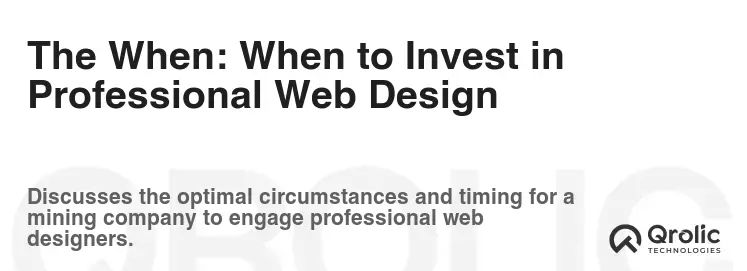
While it’s possible to create a basic website yourself, investing in professional web design can provide significant benefits, especially for a mining company. Here’s when you should consider hiring a professional:
- When You Need a Custom Design: If you want a unique website that reflects your brand and stands out from the competition, a professional designer can create a custom design that meets your specific needs.
- When You Need Advanced Functionality: If you require advanced features such as interactive maps, document downloads, or online training modules, a professional developer can build these features for you.
- When You Need SEO Expertise: If you want to improve your website’s search engine ranking, a professional SEO expert can optimize your website for relevant keywords and implement other SEO best practices.
- When You Don’t Have the Time or Expertise: Creating and maintaining a website can be time-consuming and complex. If you don’t have the time or expertise, hiring a professional can save you time and ensure your website is well-designed and maintained.
- When You Need Ongoing Support: A professional web design agency can provide ongoing support and maintenance to ensure your website remains secure, up-to-date, and effective.
The Who: Finding the Right Web Design Partner
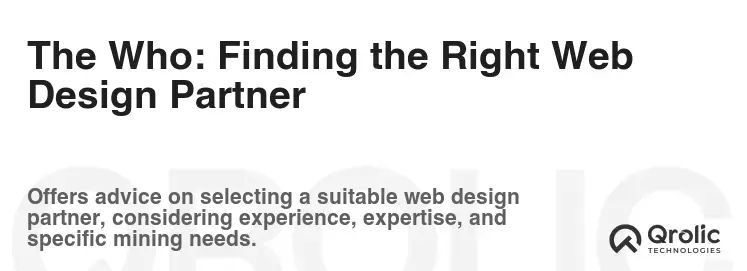
Choosing the right web design partner is crucial for the success of your website project. Here’s what to look for:
- Experience: Look for a web design agency with experience in the mining industry or related industries.
- Portfolio: Review their portfolio to see examples of their previous work.
- Testimonials: Read testimonials from their clients to get an idea of their reputation and quality of service.
- Communication: Choose an agency that communicates clearly and responds promptly to your inquiries.
- Pricing: Get quotes from multiple agencies and compare their pricing and services.
- Support: Ensure the agency offers ongoing support and maintenance.
Industrial Web Design: The Specific Needs of Mining Companies
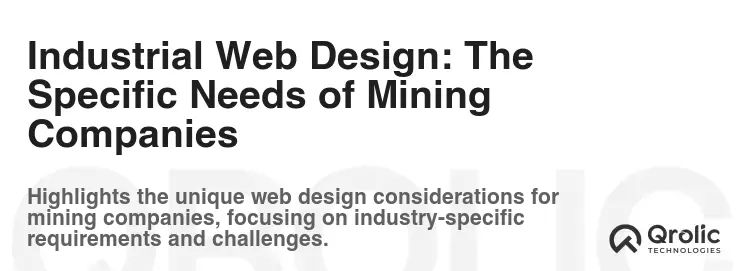
Industrial web design differs from standard web design due to the unique challenges and requirements of industries like mining. Here are key considerations:
- Technical Expertise: Understanding the technical aspects of mining operations, such as geological data, mining processes, and environmental regulations, is crucial for creating relevant and informative content.
- Visual Representation: Using high-quality images and videos to showcase complex mining operations and equipment.
- Data Visualization: Presenting technical data in a clear and understandable format through interactive charts, graphs, and maps.
- Security: Implementing robust security measures to protect sensitive data and prevent cyberattacks.
- Compliance: Ensuring the website complies with all relevant industry regulations and standards.
- Mobile Optimization: Optimizing the website for use in remote locations with limited internet connectivity.
SEO for Mining Company Websites: Attracting the Right Audience
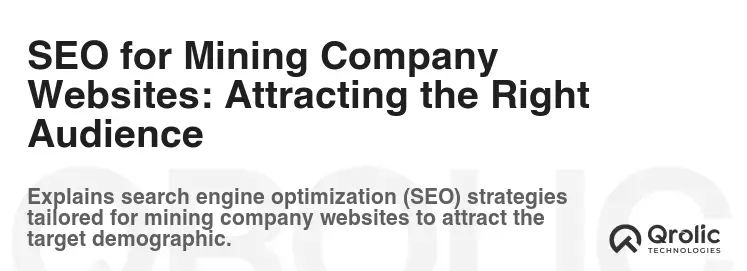
Search engine optimization (SEO) is essential for driving traffic to your website and attracting potential customers, investors, and employees. Here are some key SEO strategies for mining company websites:
- Keyword Research: Identify relevant keywords that your target audience is searching for.
- On-Page Optimization: Optimize your website’s content, meta descriptions, and alt tags for your target keywords.
- Technical SEO: Improve your website’s technical aspects, such as site speed, mobile responsiveness, and site architecture, to improve its search engine ranking.
- Link Building: Build high-quality backlinks from other websites to increase your website’s authority and credibility.
- Content Marketing: Create informative and engaging content that attracts and engages your target audience.
- Local SEO: Optimize your website for local search to attract customers in your area.
Qrolic Technologies: Your Partner in Mining Website Creation
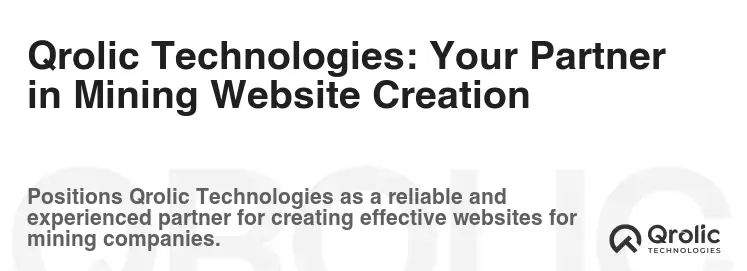
Qrolic Technologies is a leading provider of web design and development services, specializing in creating custom websites for industrial companies, including mining companies. We understand the unique challenges and requirements of the mining industry and can help you create a website that effectively showcases your company, attracts investors, recruits employees, and streamlines communication.
Why Choose Qrolic Technologies?
- Industry Expertise: We have experience working with mining companies and understand the industry’s specific needs.
- Custom Design: We create custom website designs that reflect your brand and stand out from the competition.
- Advanced Functionality: We can build advanced features such as interactive maps, document downloads, and online training modules.
- SEO Expertise: We optimize your website for search engines to improve your ranking and drive traffic.
- Ongoing Support: We provide ongoing support and maintenance to ensure your website remains secure, up-to-date, and effective.
Our Services Include:
- Website Design and Development: Creating custom websites tailored to your specific needs.
- SEO Optimization: Improving your website’s search engine ranking.
- Content Creation: Developing informative and engaging content for your website.
- Website Maintenance: Providing ongoing support and maintenance.
- Digital Marketing: Promoting your website through various marketing channels.
Contact Qrolic Technologies today to discuss your mining company website needs and learn how we can help you achieve your business goals.
The Future: Emerging Trends in Mining Company Websites
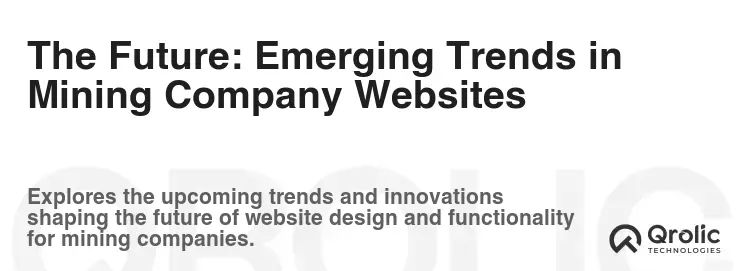
The digital landscape is constantly evolving, and mining companies need to stay ahead of the curve to remain competitive. Here are some emerging trends in mining company websites:
- Virtual Reality (VR) and Augmented Reality (AR): Using VR and AR to provide immersive experiences of mining operations and projects.
- Artificial Intelligence (AI): Implementing AI-powered chatbots to provide instant customer support and answer frequently asked questions.
- Big Data Analytics: Using big data analytics to track website performance and identify areas for improvement.
- Blockchain Technology: Using blockchain technology to enhance transparency and traceability in the supply chain.
- Sustainability Reporting: Integrating detailed sustainability reporting into the website to demonstrate commitment to environmental and social responsibility.
By embracing these emerging trends, mining companies can create websites that are not only informative and engaging but also innovative and forward-thinking.
In conclusion, creating a successful mining company website requires careful planning, execution, and ongoing maintenance. By following the steps outlined in this guide and partnering with a reputable web design agency like Qrolic Technologies, you can create a website that effectively showcases your company, attracts investors, recruits employees, and streamlines communication. Your online presence is a vital asset in today’s digital world, so invest wisely and build a website that truly represents your company’s values and capabilities.
